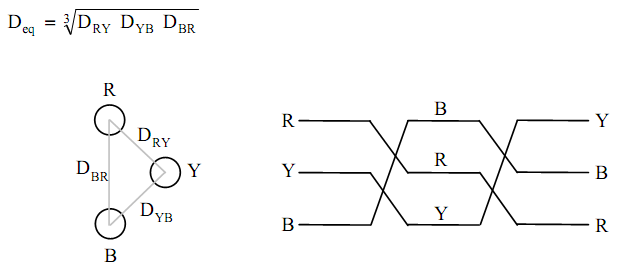Define Lines Parameters
In power system analysis, the parameters of interest when modelling power lines are: inductance, capacitance, series resistance and leakage resistance. A 3-phase line with equilateral spacing of the conductors is shown in Figure. When performing power system studies on 3-phase systems it is usual to use a single-phase equivalent circuit. Therefore, the equivalent 1-phase or line to neutral (hypothetical neutral conductor) equivalent parameters are of interest. It can be shown that the 1-phase equivalent inductance and capacitance of a 3-phase line (assuming D > > r) are given as:

where D is the distance between the centres of the conductors,
r is the radius of the conductors,
μo = 4 π × 10-7 H/m is the free space magnetic constant,
εo = 8.854 × 10-12 F/m is the free space electric constant.
It may be of interest to note that L × C = μo × εo
If the conductors are not spaced in the equilateral formation, the flux linkages and hence the inductance of each phase are not the same. It follows that the resultant 3-phase circuit is unbalanced even when the supply voltages and the load currents are balanced. To provide for this problem, the position of the conductors are exchanged at regular intervals along the line, as shown in Figure.
This technique is called 'Transposition'.
In this case, an equivalent spacing between conductors is normally used as:

The series resistance of the line is the effective a.c. resistance of the conductors which is higher than the d.c. resistance due to skin effect. The leakage resistance represents the combined effect of all various paths from the conductor to earth. It is difficult to assess the value of the leakage resistance due to its dependence on the weather conditions. Normally, its value is very high for most calculation purposes, and the leakage current is negligible.